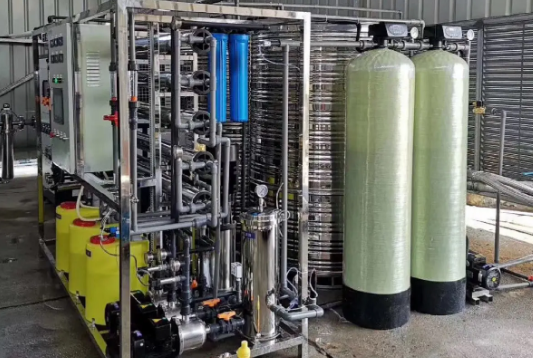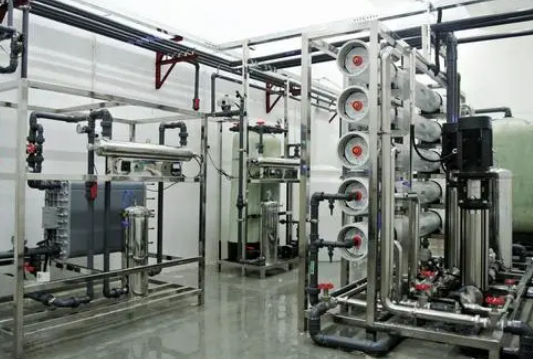The basic working principle of EDI (Electro-de-ionization) is a combination of ion exchange technology, ion exchange membrane technology and ion electromigration technology (electrodialysis technology) of pure water manufacturing technology. The technology uses ion exchange to overcome the depth of desalination of electrodialysis polarization and desalination is not complete, and the use of electrodialysis polarization and the occurrence of water ionization to produce H and OH ions to achieve self-regeneration of the resin to overcome the defects of the resin failure through the regeneration of chemicals, is the 1980s since the gradual emergence of the new technology.

After more than ten years of development, EDI technology has occupied a considerable part of the ultra-pure water market in North America and Europe.
EDI device includes anion/cation exchange membrane, ion exchange resin, DC power supply and other equipment. The anion exchange membrane only allows anions to pass through, does not allow cations to pass, while the cation exchange membrane only allows cations to pass through, does not allow anions to pass. The ion exchange resin is sandwiched between the anion and cation exchange membranes to form a single treatment unit and a fresh water chamber.
The units are separated from each other by a mesh to form a concentrated water chamber. At both ends of the unit group, the DC power supply forms an electric field at the anode and cathode electrodes. The incoming water flows through the fresh water chamber, and the anions and cations in the water are removed by the anion and cation exchange membranes under the action of the electric field and enter the concentrated water chamber. The ion exchange resin filled between the ion exchange membrane greatly improves the speed of ion removal. At the same time, water molecules generate hydrogen ions and hydroxide ions under the action of the electric field, and these ions continuously regenerate the ion exchange resin to keep it in good condition.
The EDI unit divides the feed water into three separate streams: pure water, concentrated water, and extreme water. Pure water (90%-95%) is the final water, concentrated water (5%-10%) can be recycled, and polar water (1%) is discharged.
EDI device belongs to the refined water system, generally more with reverse osmosis (RO) with the use of the composition of pretreatment, reverse osmosis, EDI device of ultrapure water treatment system, replacing the traditional water treatment process of mixed ion exchange equipment. EDI device feed water requirements for the resistivity of 0.025-0.5MΩ-cm, reverse osmosis devices can fully meet the requirements. EDI device can produce ultrapure water with resistivity as high as 15MΩ-cm or more.

EDI device features EDI device does not require chemical regeneration, continuous operation, and thus do not need the traditional water treatment process of mixed ion exchange equipment regeneration of the acid and alkali solution required, as well as regeneration of the wastewater discharged. Its main features are as follows: continuous operation, stable product water quality.
Easy to realize fully automatic control.
No need to use acid and alkali regeneration.
No downtime due to regeneration.
Saves regeneration water and regeneration sewage treatment facilities.
High water yield (up to 95%).
No need for acid/alkali reserve and acid/alkali dilution and transportation facilities.
Small footprint.
Safe and reliable use, avoiding workers' contact with acid and alkali.
Reduced operation and maintenance costs.
Modularized equipment unit, flexible combination of various flow rates of water purification facilities.
Simple installation and low cost.
EDI device and ion exchange equipment comparison EDI device and ion exchange equipment belongs to the water treatment system in the fine treatment equipment, the following two types of equipment in the water quality, investment and operating costs to compare, to illustrate the superiority of EDI device in the application of water treatment.
(1) Comparison of product water quality EDI device is a continuous water purification process, so its product water quality is stable, resistivity is generally 15MΩ-cm, up to 18MΩ-cm, up to the indicators of ultrapure water. Ion exchange facilities of the water purification process is intermittent, just after being regenerated, the product water quality is higher, and before the next regeneration, the product water quality is poor.
(2) Comparison of the amount of investment and ion exchange facilities compared to the EDI device investment is about 20% higher, but from the mixed bed needs acid and alkali storage, acid and alkali added and wastewater treatment facilities and post maintenance, resin replacement, the cost difference between the two in about 10%. With the improvement of technology and mass production, EDI device investment will be greatly reduced. In addition, EDI device equipment is small, the required plant is much smaller than the mixed bed.
(3) Comparison of operating costs EDI device operating costs, including power consumption, water consumption, pharmaceuticals and equipment depreciation costs, eliminating the consumption of acid and alkali, regeneration of water, wastewater treatment and sewage discharge costs.
In terms of power consumption, EDI device is about 0.5kWh/t of water, mixed-bed process is about 0.35kWh/t of water, the cost of power consumption in the power plant is more economical.
In terms of water consumption, EDI device water yield is high, no regeneration of water, so the operating costs in this regard is lower than the mixed bed.
The application of EDI technology EDI technology is widely used in foreign countries for more than ten years, mostly used in the pharmaceutical industry, microelectronics industry, power generation industry and laboratories. In the surface cleaning, surface coating, electrolysis industry and chemical industry applications are also increasingly widespread.
EDI device belongs to the water treatment equipment, with continuous water production, high water quality, easy to control, occupies an area of less, no acid and alkali, environmental protection and other advantages, has a wide range of prospects for application. With the improvement of equipment and technology and optimized for different industries, the initial investment costs will be greatly reduced. It can be believed that in the near future will completely replace the traditional water treatment process of mixed ion exchange equipment.
If you are interested in our products or you need to purchase industrial water treatment equipment, please feel free to contact us.







